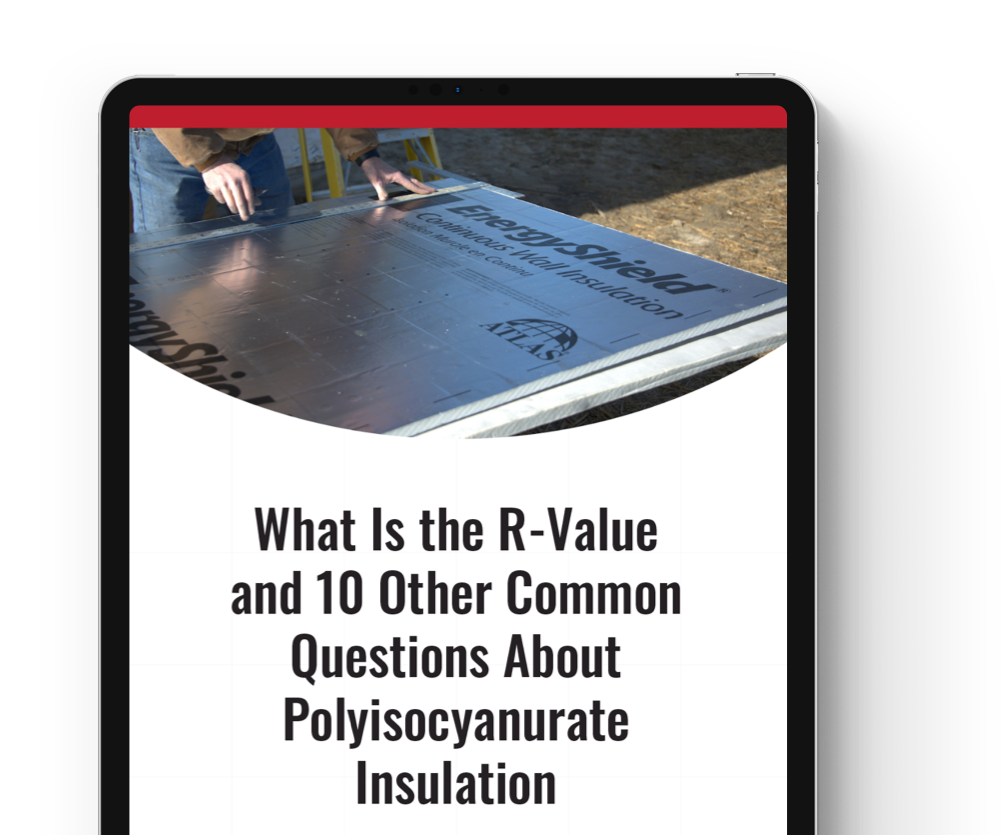THE IDEAL WALL
Imagine a wall with an uninterrupted thermal barrier that keeps the building envelope protected and ensures long-term energy efficiency. It’s also water, air, and vapor resistive, cost effective and can be used in a variety of fire-resistive assemblies. With more than 30 years’ industry expertise in polyiso manufacturing, Atlas EnergyShield continuous wall insulation products deliver confidence with proven envelope management performance.
Choose a path through the website, catered to your needs and background, or click on individual products to learn more.
Whether you’re designing, constructing or considering improvements to a building, you can count on EnergyShield products for every stage of your build. The Atlas EnergyShield family of products is proven to deliver outstanding performance and lasting energy efficiency. From thermal control to protection against moisture, to air and vapor resistance, Atlas wall insulation offers a breadth of benefits and the industry’s widest range of solutions for every project type.
THE ATLAS ADVANTAGE
Atlas EnergyShield products contain a polyiso core, which achieves higher effective
R-values (the capacity to resist heat flow) with minimal material thickness. Thinner boards take up less space than other rigid foam insulation products for the same R-value and allow better control over the wall profile by minimizing the total wall thickness which can allow for more usable floor space.
THERMAL BENEFITS
- Polyiso continuous insulation can eliminate thermal bridging at the studs. Higher R-values than the same thickness of XPS and mineral fiber, polyiso R-value increases exponentially with thickness.
- Smaller, more consistent cell structure than competitive foam products help ensure long-term high R-values.
- Reduced board thickness allows for a more efficient wall assembly.
- Properly detailed CI wall assemblies can control exterior core wall temperature which can prevent wetting events (dew point) within the wall assembly.
All Atlas boards have passed the ASTM 2178 requirement for air barrier materials and can be part of a properly detailed and sealed air barrier assembly. Joints are taped or sealed with proper flashing and sealants at rough openings, roof-wall intersections and below grade connections, to provide more protection from air and water vapor infiltration– which can lead to condensation and degradation.
AIR BENEFITS
- Polyiso is prescriptively defined as an air barrier material by IECC and ASHRAE 90.1-2010.
- Improves energy efficiency by limiting air movement.
- Included as part of an air barrier assembly project.
- Protects interiors and wall cavities from moisture-laden air—a cause of condensation, rot, and rust.
- Air barriers are required in many areas of North America to stem energy losses and avert moisture damage from trapped water vapor.
A water-resistive barrier (WRB) is essential for wall performance, in addition to an air barrier to protect against unwanted air leakage and the moisture it brings.
WATER BENEFITS
- Foil and glass facers are integral water-resistant barriers (WRB), listed by the ICC Evaluation Service (ICC-ESR-1375), when joints are properly taped and sealed.
- Closed-cell core and engineered facers make Atlas EnergyShield continuous wall insulation an ideal WRB when properly detailed.
- Absorbs less than 1% water (by volume) when immersed.
- Seals the building like a housewrap or other WRB, but with the added value of insulation.
- Reduces costs and installation time—no need for the extra trip around the building to put in a separate WRB. That means lower costs and installation of just one product.
- Secondary drainage plane and barrier when properly taped or sealed at board joints, flashings, roof assemblies.
- Minimizes stud and fastener “ghosting” caused by condensation on exterior cladding.
- Neither foam nor facers are a food source for mold.
Atlas EnergyShield wall insulation boards are available in a variety of facer materials depending on your building philosophy. Whether you prefer to lock moisture out with an impermeable barrier or a semi impermeable barrier to promote breathability, Atlas has an option for you. EnergyShield wall insulation is available with coated glass or foil facers.
The appropriate thickness of exterior insulation can play an integral role in the vapor control strategy by keeping the wall cavity sufficiently warm, eliminating thermal bridging, and promoting vapor diffusion for drying over time.
VAPOR BENEFITS
- Protects the building by minimizing water vapor entry through the exterior wall.
- Can reduce the potential for condensation by its low perm rating (less water vapor) and high insulating value.
- Helps avoid condensation by moderating temperatures inside the stud cavity or back-up wall assembly, and controlling dew point location.
In fire testing, polyiso chars in place and doesn’t melt or drip like other foam plastics. Atlas EnergyShield Pro-Series boards are also Class A fire-rated thermoset materials, which means they are approved components in UL listed wall assemblies. Atlas offers more NFPA 285 approved assemblies than any other rigid insulation manufacturer.
FIRE BENEFITS
- Unlike rigid XPS continuous insulation, Atlas EnergyShield Pro and Pro 2 do not require mineral wool above window headers.
- EnergyShield Pro products can be used in a wide variety of NFPA 285 Tested Assemblies.
- CAN/ULC S102 Burn Characteristics.
- Multiple UL listed assemblies.
- Class A and Class B products available.
- Polyiso does not melt at low temperatures like other rigid foam products.
- Polyiso, due to its fire resistant properties, is a proven material used in billions of sf of low slope roofing assemblies and is an ideal choice for high performance wall systems. (Polyiso chars in place and does not melt like XPS when burned).
Atlas EnergyShield products can help earn LEED® credits and meet federal, state and local green building laws, such as California’s CALGreen. Atlas manufacturing processes are also sustainable and responsible, with polyiso using fewer resources to produce highest insulation levels products. EnergyShield wall products have zero ozone depletion potential (ODP) and virtually no global warming potential (GWP), helping to reduce energy use and carbon emissions.
ENVIRONMENTAL BENEFITS
- HCFC-free, CFC-free, HFC-free blowing agent technology.
- Available within 500 miles of most project sites in North America. Large manufacturing footprint means lower transport cost to jobsites.
- Boards with higher R-values per inch mean that less transport and freight are required vs. mineral fiber, XPS or EPS insulation.
- Uniform Atlas production methods ensure quality control for more precise applications and more consistent thermal performance than field-applied spray foams.
- EnergyShield® boards are stable, strong, water resistant, and can be reused.
- Polyiso lifecycle assessment (LCA) indicates that polyiso energy savings and reduced global warming (GWP) potential during use outweigh energy and GWP emissions associated with making, transporting, installing and managing polyiso at end-of-life.
- Effective use of continuous insulation can support a reduction in HVAC equipment specs to heat/cool the same size building.
Atlas polyiso has been tested for VOC and formaldehyde emissions, in which reported emissions were below the emission levels allowed under both the GREENGUARD and GREENGUARD Schools and Children criteria. Foam is also not a food source for mold, making it a safe choice for indoor air quality.
AIR QUALITY BENEFITS
- Low VOC and formaldehyde emissions.
- Does not support mold growth.
- Maintains temperature in exterior wall cavity to control dew point location.
- Polyiso protects the building by minimizing water vapor entry though the exterior wall, minimizing the growth of mold due to moisture.








